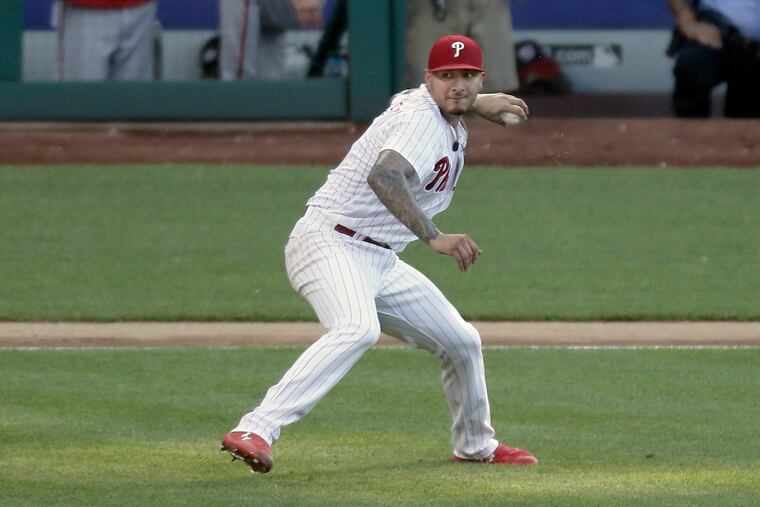Phillies pitcher Vince Velasquez can throw with either hand. What does that say about his brain?
True ambidexterity is almost unheard of, but elite athletes often learn to use either hand for a particular skill. Does that mean their brains are more flexible?

As millions have now seen in a startling replay from Saturday's Phillies game, pitcher Vince Velasquez has the rare ability to throw with either arm.
Is it correct to call him ambidextrous? Scientists say probably not. But they would love to see an MRI of his brain.
A line drive smacked Velasquez in his dominant right arm during the game against the Nationals, yet he somehow managed to pick up the ball and throw the runner out — using his left hand.
"I was just trying to make a throw," he said afterward. "I didn't know where the ball was going to go."
Natural ambidexterity — the ability to perform any task easily with either hand or foot — is very unusual. Scientists generally do not even use that term, referring instead to degrees of left- or right-"handedness," said Ruth Propper, a professor of psychology at Montclair State University.
Still, athletes in many sports train themselves to perform specific skills from either side. What is not clear is why some are better at it than others.
The number varies depending on how the term is defined, but perhaps 85 percent of people consistently favor their right hands for everyday tasks, said Jerre Levy, a retired professor of psychology at the University of Chicago. As many as 5 percent consistently use their left hands, she said. The rest fall somewhere in between, depending on the task.
An open question: If someone is inconsistently left- or right-handed, does that mean they are better able to learn a particular skill with either hand? Does it indicate something about the level of communication between the two hemispheres in the brain?
Propper said that might be the case, but stressed that it was pure speculation. Adrenaline may have given Velasquez a boost on his spectacular throw, and perhaps he is simply a good athlete, she said.
No argument there, Phillies manager Gabe Kapler said after the game.
> > READ MORE: The physics behind that record-setting Eagles field goal
"It's well-known that he is one of the better athletes on our team," Kapler said. "What we didn't know was that he could get one of the faster runners in baseball after getting smoked in the forearm, with his opposite hand."
Officially listed as a righthander on the Phillies roster, Velasquez evidently honed his left-handed throwing ability years earlier, out of necessity. As a junior in high school, he suffered bone spurs in his right hand but managed to play center field with his left, he told reporters.
The history of training people to use the non-dominant hand is fraught with abuse, as left-handedness was once the source of stigma. As late as the mid-20th century, some teachers in the United States punished students for writing with their left hand.
> > READ MORE: Is Joel Embiid's size an injury risk? Here's the science
These days, athletes voluntarily seek to sharpen their skills on both sides. Whether it's a basketball player who can drive to the hoop with the ball in either hand, or a soccer player who can dribble and shoot equally well with both feet, the goal is to outfox defenders.
In baseball, pitchers who can use either arm are extremely rare, but most Major League teams have a batter or two who is adept from both sides of the plate. Among the most famous switch-hitters was the Phillies' own Pete Rose. But that skill is said to be declining, possibly because improvements in defensive techniques have negated some of the advantage.
And it is not easy. Mike Zolk, owner of Zoom Baseball Academy in Northeast Philadelphia, said some athletes may be daunted by the time required to learn switch-hitting. If a player has grown up batting exclusively from one side of the plate, he or she commonly needs at least a year to learn to swing from the other side, Zolk said. Among the more than 800 hitters on Zoom's client roster, just 14 are training as switch-hitters, he said.
Outside the sports realm, some commercial ventures now claim that training to use either side can improve brain function. Formal scientific evidence for such claims is limited, but there is no indication the practice can hurt, said Chicago's Levy.
From a baseball perspective, on the other hand, the evidence is pretty clear. Just ask Velasquez.